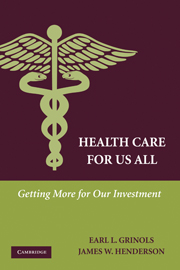Book contents
- Frontmatter
- Contents
- List of Tables
- List of Figures
- Preface
- Acknowledgments
- Executive Summary of the Targeted Intervention Plan
- PART I GOALS AND WORKING PRINCIPLES
- PART II BACKGROUND ECONOMICS AND ETHICS
- PART III APPLICATION
- PART IV PROTECTIVE MEASURES
- A Top Ten Goals for the American Health Care System
- B Badly Done Insurance Programs Can be Worse Than No Insurance
- C Incentive Symmetry and Intervention Principle
- D Plan Workability
- E Market Power Response to Insurance
- Glossary and Definitions
- References
- Index
A - Top Ten Goals for the American Health Care System
Published online by Cambridge University Press: 05 June 2012
- Frontmatter
- Contents
- List of Tables
- List of Figures
- Preface
- Acknowledgments
- Executive Summary of the Targeted Intervention Plan
- PART I GOALS AND WORKING PRINCIPLES
- PART II BACKGROUND ECONOMICS AND ETHICS
- PART III APPLICATION
- PART IV PROTECTIVE MEASURES
- A Top Ten Goals for the American Health Care System
- B Badly Done Insurance Programs Can be Worse Than No Insurance
- C Incentive Symmetry and Intervention Principle
- D Plan Workability
- E Market Power Response to Insurance
- Glossary and Definitions
- References
- Index
Summary
Many documents describe Americans' desires and goals for their health care. Interested parties include users, providers, and government. Insurance companies also have a critically large role in a sustainable well-functioning system. Referencing only a handful of documents is sufficient to reveal that a great degree of commonality exists in the themes that emerge. This appendix produces an unscientific “Top Ten List” that is reduced by policy triage to three points of policy focus that, when addressed, accomplish the five objectives in Chapter 2. With one exception, all of those objectives are themselves points of policy interest. The exception is the objective of patient-centered coverage. Patient-centered coverage is achieved as a consequence of making sure that everyone has enough income to buy health insurance coverage and is covered by adequate health insurance of the right kind. Coupled with market provision of health care, this makes the patient the key decision-making unit. Patient-centered coverage was listed as a stand-alone objective to emphasize its importance. Generally, the meaning of the items on the list needs no explanation. A summary of objectives by organization follows. Table A.1 distributes the ten goals into the policy triage groups based on the description of the Preface. Columns (2) and (4) are not objects of policy for the reasons described in the first row of the table. Column (3) lists goals that should be addressed and solved.
- Type
- Chapter
- Information
- Health Care for Us AllGetting More for Our Investment, pp. 215 - 224Publisher: Cambridge University PressPrint publication year: 2009

